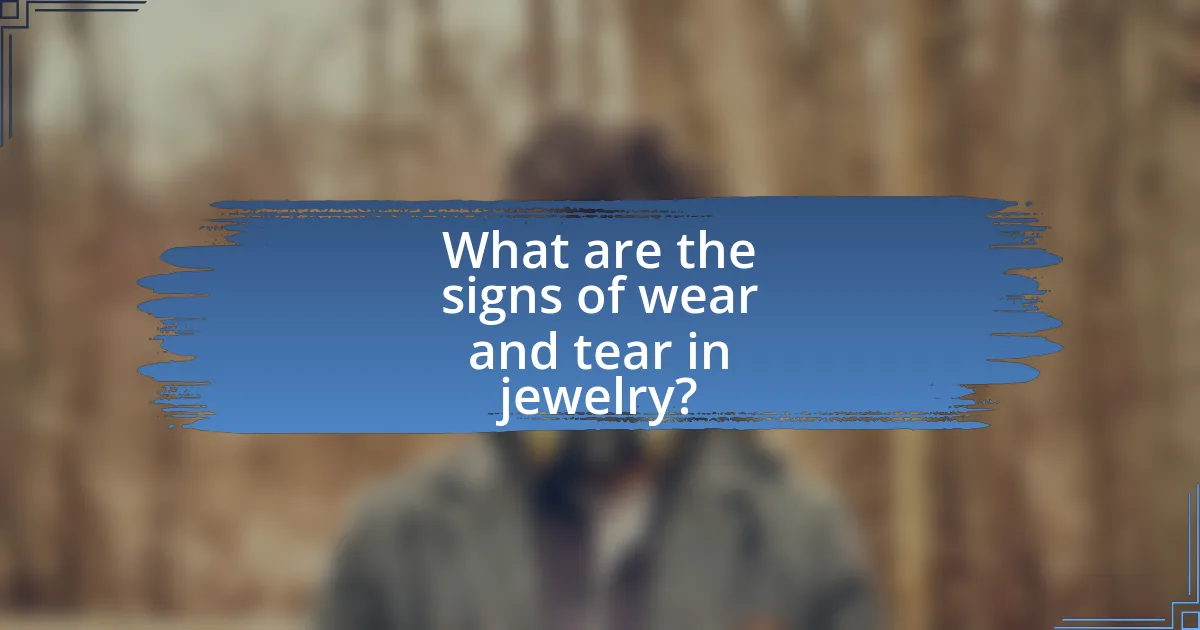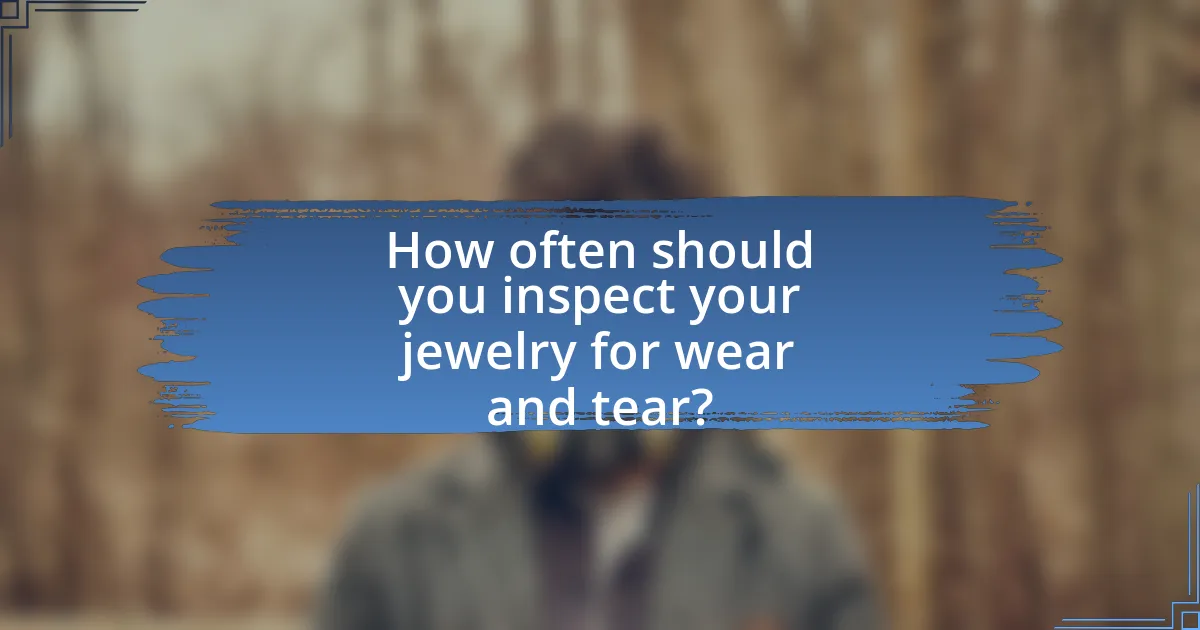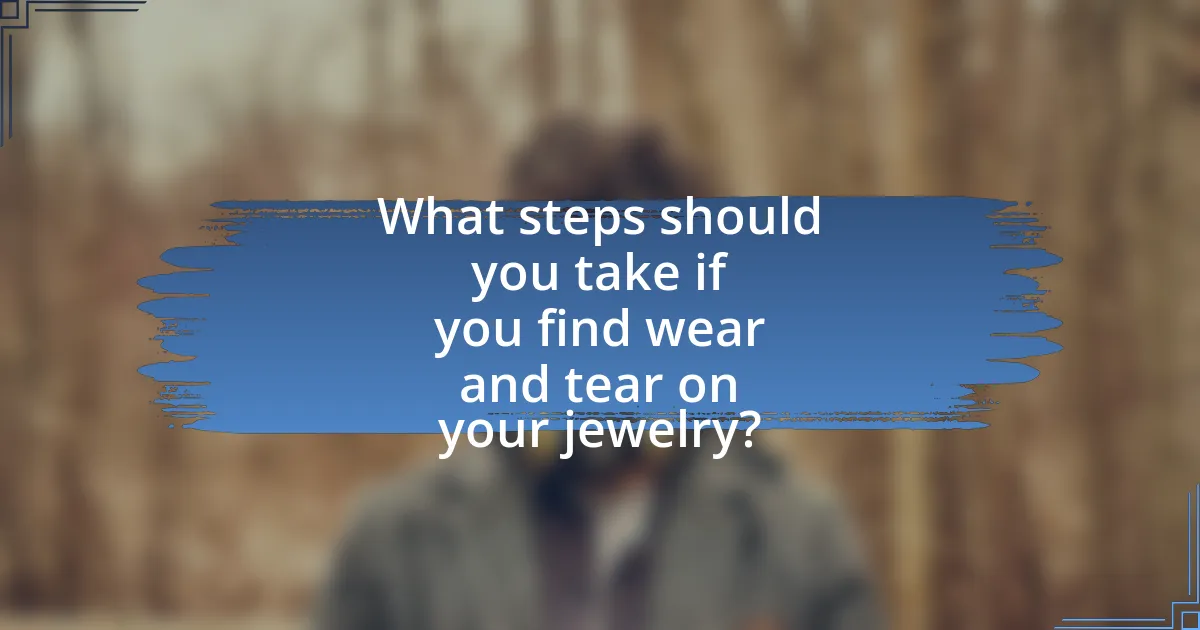The article focuses on essential tips for inspecting jewelry for signs of wear and tear, emphasizing the importance of regular maintenance to preserve its integrity and appearance. Key indicators of wear include scratches, tarnishing, loose stones, and changes in color or shape. The article outlines methods for identifying scratches and dents, tools for detailed inspections, and best practices for maintaining gemstones and settings. It also discusses the significance of inspecting clasps and closures, the frequency of inspections based on lifestyle factors, and practical steps for addressing minor damages at home or seeking professional help when necessary.

What are the signs of wear and tear in jewelry?
The signs of wear and tear in jewelry include scratches, tarnishing, loose stones, and changes in color or shape. Scratches on the surface indicate frequent use, while tarnishing, often seen in silver, suggests exposure to moisture or chemicals. Loose stones can result from weakened settings, and noticeable changes in color or shape may indicate structural damage. Regular inspection for these signs is essential to maintain the integrity and appearance of jewelry.
How can you identify scratches and dents on your jewelry?
To identify scratches and dents on your jewelry, closely examine the surface under good lighting and use a magnifying glass for detailed inspection. Scratches appear as fine lines or marks on the metal or gemstone surfaces, while dents manifest as small, indented areas that disrupt the smoothness of the jewelry. Regularly inspecting your jewelry can help you notice these imperfections early, allowing for timely repairs.
What tools can assist in detecting scratches on metal surfaces?
Tools that can assist in detecting scratches on metal surfaces include magnifying glasses, optical microscopes, and scratch detection kits. Magnifying glasses allow for close inspection of the surface, revealing fine scratches that may not be visible to the naked eye. Optical microscopes provide a more detailed view, enabling the identification of surface imperfections at a microscopic level. Scratch detection kits often contain specialized powders or liquids that highlight scratches by contrasting with the metal surface, making them easier to see. These tools are essential for thorough inspections, especially in jewelry care, where maintaining the integrity of metal surfaces is crucial.
How do you differentiate between surface scratches and deeper damage?
To differentiate between surface scratches and deeper damage, examine the depth and visibility of the marks on the jewelry. Surface scratches are typically shallow, affecting only the top layer of the material, while deeper damage penetrates beyond the surface, often creating noticeable grooves or altering the shape of the item. For instance, if a scratch can be felt with a fingernail or shows discoloration beneath the surface, it indicates deeper damage. Additionally, using a magnifying glass can help reveal the extent of the damage; surface scratches will appear less pronounced under magnification compared to deeper abrasions that may show more significant wear.
What should you look for in gemstones and settings?
When inspecting gemstones and settings, prioritize clarity, cut, color, and carat weight for gemstones, while ensuring the setting is secure and free from damage. Clarity refers to the absence of inclusions or blemishes, which can affect the stone’s brilliance; for example, diamonds are graded on a scale from Flawless to Included. The cut influences how well the gemstone reflects light, with well-cut stones exhibiting superior sparkle. Color should be vibrant and even, particularly for colored gemstones, as this impacts their overall value. Carat weight indicates the size of the gemstone, with larger stones typically being more valuable.
For settings, check for signs of wear such as bent prongs, loose stones, or scratches on the metal. A secure setting is crucial to prevent loss of the gemstone; for instance, a four-prong setting is generally more secure than a two-prong setting. Regular inspections can help maintain the integrity of both the gemstones and their settings, ensuring longevity and preserving value.
How can you check for loose stones in your jewelry?
To check for loose stones in your jewelry, gently press on each stone with your fingertip to see if it moves or shifts. If a stone feels loose or wobbly, it may indicate that the setting is compromised. Additionally, inspect the prongs or settings holding the stones; they should be secure and not bent or damaged. Regular checks are essential, as loose stones can lead to loss or further damage.
What are the indicators of a damaged setting?
Indicators of a damaged setting include loose stones, visible cracks, and discoloration of the metal. Loose stones suggest that the prongs or settings may have weakened, increasing the risk of losing the gemstone. Visible cracks in the setting can compromise its structural integrity, while discoloration often indicates corrosion or wear, which can weaken the metal. Regular inspection for these signs is essential to maintain the integrity of jewelry.
Why is it important to inspect clasps and closures?
Inspecting clasps and closures is crucial for ensuring the security and longevity of jewelry. A faulty clasp can lead to the loss of valuable pieces, as it may fail to hold the jewelry in place during wear. According to a study by the Jewelers of America, approximately 30% of jewelry losses occur due to malfunctioning clasps. Regular inspection helps identify wear, corrosion, or damage, allowing for timely repairs and preventing potential loss.
What are the common issues with jewelry clasps?
Common issues with jewelry clasps include difficulty in opening and closing, wear and tear leading to breakage, and misalignment that prevents secure fastening. Difficulty in operation often arises from dirt accumulation or corrosion, which can hinder smooth movement. Wear and tear can result from frequent use, causing clasps to weaken or break, especially in delicate designs. Misalignment occurs when clasps are not properly aligned, leading to potential loss of the jewelry piece. Regular inspection and maintenance can help identify these issues early, ensuring the longevity and functionality of the clasp.
How can you test the functionality of a clasp?
To test the functionality of a clasp, securely attach the clasp to a stable object and apply gentle pressure to ensure it holds firmly. This method verifies that the clasp engages and disengages smoothly without any resistance or misalignment. Additionally, visually inspect the clasp for any signs of wear, such as fraying or bending, which could compromise its integrity. Regular testing and inspection help maintain the clasp’s reliability, ensuring it functions correctly over time.

How often should you inspect your jewelry for wear and tear?
You should inspect your jewelry for wear and tear at least twice a year. Regular inspections help identify issues such as loose stones, worn prongs, or damaged clasps before they lead to more significant problems. According to the Jewelers of America, routine maintenance and inspections can prolong the life of your jewelry and ensure its safety and appearance.
What factors influence the frequency of jewelry inspections?
The frequency of jewelry inspections is influenced by factors such as the type of jewelry, the materials used, the frequency of wear, and environmental conditions. For instance, fine jewelry made of precious metals and gemstones typically requires more frequent inspections due to its value and susceptibility to damage. Additionally, jewelry worn daily, like engagement rings, should be inspected more often compared to pieces worn occasionally. Environmental factors, such as exposure to chemicals, humidity, and temperature fluctuations, can also affect the integrity of jewelry, necessitating regular checks to ensure it remains in good condition.
How does the type of jewelry affect inspection frequency?
The type of jewelry significantly affects inspection frequency, as different materials and designs have varying levels of durability and wear. For instance, fine jewelry made from precious metals and gemstones typically requires more frequent inspections due to their susceptibility to scratches, loose settings, and tarnishing. In contrast, fashion jewelry, often made from less durable materials, may need less frequent checks but can still suffer from wear and tear, such as discoloration or breakage. Regular inspections, ideally every six months for fine jewelry and annually for fashion pieces, help ensure the longevity and integrity of the items, preventing costly repairs or loss.
What lifestyle factors should be considered for inspection schedules?
Lifestyle factors that should be considered for inspection schedules include frequency of wear, exposure to chemicals, and lifestyle activities. Frequent wear increases the likelihood of wear and tear, necessitating more regular inspections. Exposure to chemicals, such as those found in cleaning products or cosmetics, can damage jewelry, making it essential to inspect items after such exposure. Additionally, lifestyle activities like sports or manual labor can subject jewelry to physical stress, warranting more frequent checks to ensure integrity and safety.
What are the best practices for regular jewelry maintenance?
The best practices for regular jewelry maintenance include cleaning, inspecting, and storing jewelry properly. Regular cleaning with a soft cloth or a gentle jewelry cleaner helps remove dirt and oils that can dull the appearance of the pieces. Inspecting jewelry for loose stones, worn prongs, or signs of damage ensures that any issues are addressed before they worsen. Proper storage in a dry, separate compartment prevents scratches and tangling. According to the Gemological Institute of America, these practices can significantly extend the lifespan of jewelry and maintain its value.
How can cleaning routines help in identifying wear and tear?
Cleaning routines can help in identifying wear and tear by revealing hidden damage and deterioration that may not be visible otherwise. Regular cleaning allows for close inspection of jewelry, making it easier to spot scratches, loose stones, or weakened settings. For instance, during the cleaning process, dirt and grime are removed, which can obscure signs of wear. Additionally, consistent cleaning can help track changes over time, providing a clearer picture of the jewelry’s condition. This proactive approach ensures that any issues are addressed promptly, preventing further damage.
What storage methods can prevent damage to jewelry?
To prevent damage to jewelry, store pieces in individual soft pouches or compartments to avoid scratching and tangling. This method minimizes contact between different items, which can lead to wear and tear. Additionally, using a jewelry box with a lined interior provides cushioning and protection from dust and environmental factors. Research indicates that proper storage significantly extends the lifespan of jewelry, as it reduces exposure to elements that can cause tarnishing and degradation.

What steps should you take if you find wear and tear on your jewelry?
If you find wear and tear on your jewelry, the first step is to assess the extent of the damage. Examine the piece closely for any visible signs of deterioration, such as scratches, loose stones, or broken clasps. Next, clean the jewelry gently using a soft cloth to remove any dirt or oils that may obscure the damage. After cleaning, consider taking the jewelry to a professional jeweler for a thorough evaluation and repair. Professional jewelers can provide services such as resetting stones, repairing clasps, or polishing the metal to restore its original appearance. Regular maintenance, including periodic inspections and professional cleanings, can help prevent further wear and tear, ensuring the longevity of your jewelry.
How can you repair minor damages at home?
To repair minor damages at home, you can use adhesive for broken items, touch-up paint for scratches, and a simple cleaning solution for tarnished jewelry. For instance, applying super glue can effectively bond broken ceramic or glass, while using a fine brush to apply touch-up paint can conceal scratches on furniture. Additionally, a mixture of vinegar and baking soda can clean tarnished jewelry, restoring its shine. These methods are practical and widely recommended for maintaining household items.
What DIY methods are effective for fixing scratches?
Effective DIY methods for fixing scratches include using a polishing cloth, applying a mixture of baking soda and water, and utilizing a commercial scratch remover. Polishing cloths can buff out minor scratches on metal surfaces, restoring shine. A paste made from baking soda and water can be gently rubbed onto the scratched area, which acts as a mild abrasive to smooth the surface. Commercial scratch removers, specifically designed for jewelry, contain compounds that fill in and diminish the appearance of scratches. These methods are widely recognized for their effectiveness in jewelry maintenance.
When is it appropriate to use jewelry repair kits?
Jewelry repair kits are appropriate to use when minor repairs are needed, such as fixing loose stones, reattaching clasps, or repairing broken chains. These kits typically contain essential tools and materials that allow individuals to perform quick fixes without professional assistance. For instance, if a ring’s prong is bent or a necklace chain has come apart, a jewelry repair kit can provide the necessary tools like pliers, adhesive, or replacement parts to restore the item. Using these kits is particularly beneficial for routine maintenance and small repairs, enabling jewelry owners to extend the life of their pieces effectively.
When should you seek professional help for jewelry repairs?
You should seek professional help for jewelry repairs when you notice significant damage, such as broken clasps, missing stones, or bent prongs. These issues can compromise the integrity and safety of the jewelry, making it essential to consult a professional jeweler who has the expertise and tools to perform proper repairs. Additionally, if you observe signs of wear like scratches on precious metals or loose settings, professional intervention is advisable to prevent further damage and ensure the longevity of the piece.
What types of damage require a professional jeweler’s expertise?
Types of damage that require a professional jeweler’s expertise include broken clasps, loose stones, bent or broken prongs, and damaged settings. These specific issues often compromise the integrity and security of the jewelry, making it essential for a trained jeweler to assess and repair them properly. For instance, a broken clasp can lead to loss of the piece, while loose stones may fall out if not secured correctly. Professional jewelers possess the necessary skills and tools to restore jewelry to its original condition, ensuring both aesthetic appeal and functionality.
How can you choose a reputable jeweler for repairs?
To choose a reputable jeweler for repairs, research local jewelers by checking online reviews and ratings on platforms like Google and Yelp. A jeweler with a high rating and positive customer feedback indicates reliability and quality service. Additionally, verify their credentials, such as certifications from recognized organizations like the Gemological Institute of America (GIA), which ensures they have the necessary training and expertise. Engaging with the jeweler directly can also provide insight; ask about their repair processes, warranties, and experience with specific types of jewelry. A reputable jeweler will be transparent about their methods and pricing, further establishing trust.
What are some practical tips for inspecting your jewelry regularly?
To inspect your jewelry regularly, examine each piece for signs of wear, such as loose stones, scratches, or tarnishing. Start by cleaning the jewelry with a soft cloth to remove dirt and oils, which can obscure damage. Next, check the settings of gemstones to ensure they are secure; gently wiggle each stone to see if it moves. Inspect clasps and chains for any signs of weakness or breakage, as these areas are often prone to wear. Additionally, consider using a magnifying glass to closely examine intricate details and settings. Regular inspections, ideally every few months, help maintain the integrity of your jewelry and prevent potential loss or damage.
How can you create a simple inspection checklist for your jewelry?
To create a simple inspection checklist for your jewelry, start by identifying key areas to examine, such as clasps, stones, and metal surfaces. For each piece, include specific tasks: check clasps for functionality, inspect stones for secure settings, and look for scratches or tarnishing on metal. This structured approach ensures thoroughness in identifying wear and tear. Regular inspections can prevent further damage and maintain the jewelry’s condition, as recommended by jewelers who emphasize the importance of routine checks to prolong the lifespan of jewelry.
What tools are recommended for effective jewelry inspections?
Recommended tools for effective jewelry inspections include a jeweler’s loupe, a magnifying glass, a soft cloth, and a digital scale. A jeweler’s loupe, typically 10x magnification, allows for detailed examination of gemstones and settings, revealing scratches or inclusions. A magnifying glass provides a broader view for inspecting larger pieces. A soft cloth is essential for cleaning and removing debris that may obscure damage. A digital scale helps assess the weight of precious metals, which can indicate wear over time. These tools collectively enhance the accuracy of jewelry inspections, ensuring that any signs of wear and tear are identified promptly.


